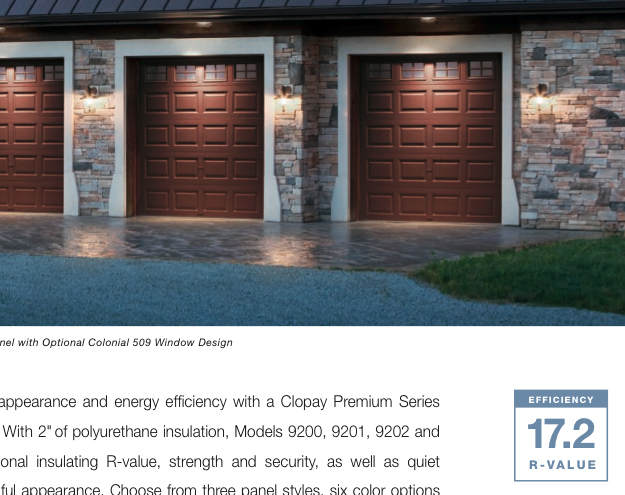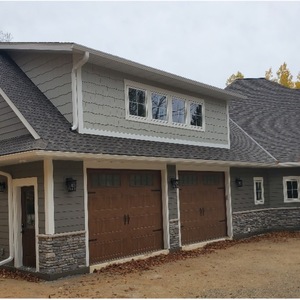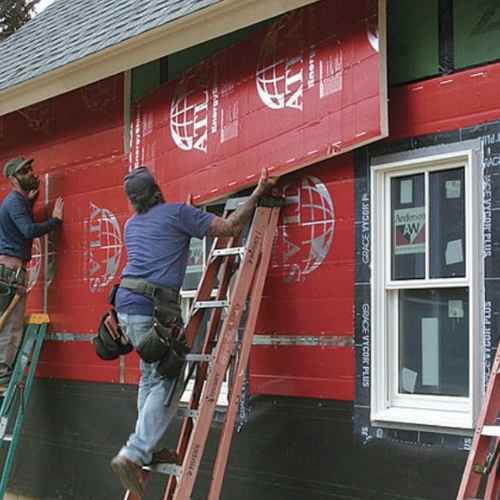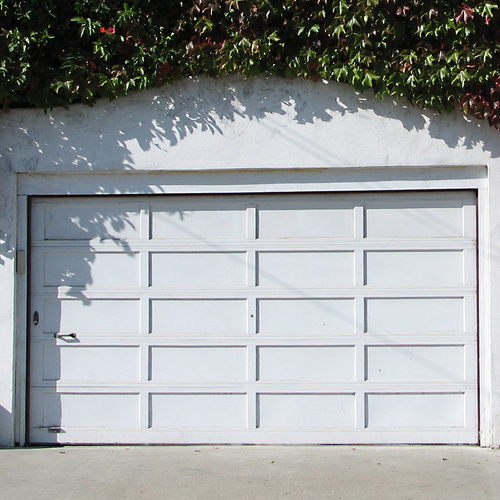
If you’re shopping for a garage door, the door’s energy performance may not matter — especially if you don’t heat your garage. However, there are a few reasons why you might be looking for a well-insulated, draft-free garage door:
- A good overhead door on an attached garage can keep the garage — and therefore the house — a little warmer than a leaky door.
- Since cars can be hard to start in sub-zero weather, homeowners in very cold climates — even those with unheated garages — may want a garage door that limits heat loss.
- If the garage is used for vehicle maintenance or woodworking projects, it may occasionally be heated.
So, how do you tell a high-performance garage door from a lemon?
“We sell high R-value doors!”
Many garage-door manufacturers advertise the R-values of their doors:
- CEDO advertises doors with R-17.09 polyurethane insulation.
- Clopay advertises that some of its doors are R-17.2.
- Overhead Door advertises that “a 17.5 R-value makes the 490 Series among the most thermally efficient doors you can buy.”
- Raynor advertises “R-values from 12.0 – 18.0.”
- Wayne-Dalton advertises garage doors with R-15 insulation.
Unfortunately, these advertised R-values are almost meaningless.
Advertised R-values are inaccurate, irrelevant — or both
To determine the thermal performance of a garage door, you need to know two things:
The R-values that are trumpeted by garage-door manufacturers are measured at the center of one of the door panels. No manufacturer, as far as I can determine, reports the R-value of the entire door assembly (including the panel edges, the seams between panels, and the perimeter of the door) in their promotional materials. Moreover, manufacturers’ reported R-values tell us nothing about air leakage.
Most garage-door manufacturers are reluctant to share actual laboratory reports showing the results of…
Weekly Newsletter
Get building science and energy efficiency advice, plus special offers, in your inbox.

This article is only available to GBA Prime Members
Sign up for a free trial and get instant access to this article as well as GBA’s complete library of premium articles and construction details.
Start Free TrialAlready a member? Log in















53 Comments
Please consider a follow up piece
Nice piece Martin! You have established the many problems of finding accurate whole door thermal performance information on garage doors. Now we know the problems but how do we sort the wheat from the shaft? Would you please consider writing a follow up blog post on which doors are "doing everything right" in the words of Mike Thoman? If you focused on exactly what "doing everything right" is in terms of door construction that could be very instructive. Thanks!
I hope I can do a follow-up
Kyle,
I'm depending on the community of GBA readers to contribute recommendations on good garage doors (and even installation tips that limit infiltration).
Sorting the wheat from the chaff is frustratingly difficult. Mike Thoman was unable to release specifics on the brand names of better doors because of confidentiality agreements signed with the manufacturers who submit their doors for testing.
Manufacturers are tight-lipped and reluctant to release lab reports.
This is what I know:
-- Designs that minimize air leakage are the best, so look for good gaskets between panels and heavy-duty weatherstripping at the bottom of the door.
-- Thin-gauge steel doesn't last as long as heavier gauge steel, so avoid doors with thin 32-ga. steel. Look instead for 24 ga. or 25 ga. steel -- or just choose a wood-panel door.
Re: I hope I can do a follow-up
Thanks for the thoughtful response Martin.
Installation will be key
As you point out Martin... "and even installation tips that limit infiltration".
Even the most thoughtfully designed door's energy efficiency detailing will be defeated by the installer.
Or, more optimistically ...
Andrew,
On a more positive note, I would say "may be defeated" instead of "will be defeated."
Creeping Pessimism
Martin,
Sorry, the pessimistic tense I used just sub-consciously crept in! Perhaps it was based on experience.
On a slight tangent to the topic of the post I'd ask the question... "Should garages be attached to living spaces in a green home in the first place?"
That said, I know that many people use garages as their workshop so garage doors that are well sealed and insulated are nevertheless needed.
Andrew
On attached garages
Andrew,
I'm not a fan of attached garages because of IAQ concerns.
In snowy or rainy climates, a detached garage can be connected to the house with a narrow unconditioned breezeway.
U-values of garage doors
Well informed article, and very timely for me. I serve on a task group that is writing new building efficiency standards for Canada, and we are currently considering mandating U-values and test procedures for overhead doors. Thanks for the insight.
Good luck, Rick
Rick,
I'm glad the article was useful. And good luck with your efforts to mandate U-factors and test procedures for overhead doors. I look forward to seeing what your task group recommends.
R-Values Of Garage Doors
Hi Martin.
You were to kind to the manufacturers of garage doors.
The true R-value of garage doors is closer to a 1/4 of what they publish.
By the way, we have increased our "R- Value Challenge" to $500.00.
Still no takers.
Look at the Garaga Standard Plus
I would like to hear your thoughts on the Garaga Standard Plus. I am a home owner currently shopping for a door. Your article confirmed many of my suspicions.
Thanks,
Jim
I'm not familiar with it
Jim,
I've had no experience with the Garaga Standard +.
Anything on Thermacore 190 or 490 series
Very good article. I'm in the process of looking for two doors. Have you heard of anything on Overhead Door's Thermacore 190 or 490 series. The 490 series claims the R-value as 17.5, while the 190 series claims an R-value of 12.76. I can't seem to find out the steel gauge but I assume it is 24 or 25. Any info would help
Thanks
Most Homeowners Are Too Overwhelmed
We install and repair doors all day, and, unfortunately, for a lot of people energy efficiency still isn't at the top of their list when it comes to the garage door. We try our best to educate, but often times the most homeowners are willing to go is repairing or adding rubber stop molding. I think what the industry needs is, like you mentioned, less anecdotes and more scientific evidence like the window manufacturers have. Some quantifiable facts about how installing the proper door is going to save them X dollars a year.
Jim from Cleveland Garage Door Repair
R-value depends on weather strip etc...
We are a manufacturer of carriage doors in Maine with weather all over the map. I have found that R-value is indeed misleading. We tell people exactly what you have stated here - that panel core and thickness do matter (we prefer polyiso instead of the cheap white foam board), but more important is the weather seal around the sides and the door bottom as well as integrity of the concrete surface the door sits on.
Also, look for a door section that has a good male/female interlocking frame - you'd be surprised by the weather that can sneak in between the panels. It's true that the entire "package" should be rated and results provided to the customer and yes, proper installation of both door and weather seal can make or break the entire system.
Garaga
I just saw your post jim. We sell Garaga weather seal with our custom carriage doors. It's one of the best on the market with a double rubber seal around the top and side jambs. - Scott from Maine Doors.
testing
Bill Feder is right. The testing is misleading and fairly expensive for a company to do because it's really not about the door - it's about the entire package. If it's installed improperly - you're wasting your money on a high R door.
correction
If it's NOT installed properly - a waste of money on a high R value door!!
Sealing the door is the ticket!
Great article! In fact, it inspired me to post info on my own garage door replacement, since a number of people asked me how I did mine. Info is here... http://mysite.verizon.net/vze7aq8e/pictures/id8.html and again, thanks for the article.
-Rod
Prey on the unknowing
Door manufactors have been doing this for years. When I get a call from a customer and the first thing they ask is R -value of our doors I know my work is cut out for me. I can show samples with the same insulation and thickness with wildly different claimed R values. If they are lying about this what else are they lying about??? The same applies to gauge of steel on panels. 25 gauge is not the same thickness among manufactors. This principles applies to track, hinges, rollers, springs, etc... Thermo breaks between panel and end stiles along with perimater and bottom seal is also very important.. Keep in mind this is the largest moving part on a home and there will be trade offs. Bottom line different types of insulation only have so much R per inch. Do the manufactors claims match this?
Energy Tax Credit
I recently bought new windows for my bedroom, and knowing what type and applying for the energy tax credit was real simple. The window industry just has their stuff together, whereas the garage door industry hasn't quite caught on to making things simple for the consumer. Found this resource that lists all the different door manufacturers and the models that qualify for the energy tax credit. Pretty helpful to have it all in one place.
Chicago Garage Door
Very ironic
Chris,
It's ironic indeed that all U.S. taxpayers are subsidizing the installation of these garage doors, which:
1. Are mostly installed on unheated garages; and
2. Are promoted by deceitful manufacturers that exaggerate the doors' R-values.
It's scandalous -- more evidence, if any is needed, that these tax credits are designed to help manufacturers push products, not to help homeowners save energy.
Thanks Martin for this useful
Thanks Martin for this useful article...Even the most helpfully designed door's energy efficiency detailing will be defeated by the installer...
Garage Door Installation
Very useful information Martin. It helps me how I need to consider U-factor and R-value. As far as I know, the U-factor is typically used with windows as a measurement of how well the product insulates. And coming to R-value, if you find a garage door, for instance, that is thick, the R value might be as high as 6.5. However if you find a lower priced garage door that is made with inexpensive materials, the R value might be something like 4.3. While the numbers may not seem that different, they are. Thanks !
Thanks to Everyone who Posted!
Alaska has an energy rebate program (in addition to the federal program) - up to $10,000 for energy related improvements... some hoops to jump through, but its a great deal. The post on 5/27 gave me a good starting place compare products - plus, it is good to know about the Garaga product. I'll do some cost comparisons locally. Now for the windows, a new boiler/water unit... and some elbow grease to caulk/insulate the gaps!
Which door should I buy?
Just looking for opinions here...
I can spend $1595 on a R 15.38 door (which as noted above is a misleading metric), that according to my installer has very good air leakage properties from the panel design.
Or I can spend $1050 on a R 8.72 door with poorer leakage problems, but still get the tax credit.
Since my garage is not heated, and between the wife and I the door will be opening and closing several times a day, I think saving the $500 is the smart way to go. There is a bedroom that's beside but above the garage that gets cold in the winter, but I'm thinking if I just open the attic above the garage and put in a good level of insulation along that wall we'll see much better energy savings than from the door we pick.
Comment on insulation for garage doors
Finally some candid talk about the real value of insulation in a garage door. It is long overdue.
Insulated Garage Doors
Hi Martin:
I just went back to this article you wrote last year and noticed all the comments and questions. There are a few I would like to respond to.
We did test Overhead Doors Model 190 series. The sample tested had an R-value of 7.83. They publish an R-value of 12.76. What’s interesting about this door is that Overhead’s certified statement says that the door has a U-value of .24 or an R-value of 4.17.
We tested a Garaga 138 sample and it came back with an R-value of 7.89. They publish a 12.
If you maintain a 65 degree temperature year round in your garage the actual savings between a door with an R-value of 12 and one with a 4 will be about 7.83 annually.
We recently tested in insulated rolling steel door. The manufacturer published an R-value of 8. The test came back with an R-value of 0.6. If you add air films you would have an R-value of 1.45. Unbelievable.
Response to Bill Feder
Bill,
Thanks for sharing all of your updated test results. I wish the FTC would prosecute the door manufacturers that continue to lie in their advertising.
An honest manufacturer
I sell and install garage doors and we use the manufacturer C.H.I. I believe they are actually honest in their R value publications, their brochures and their specifications sheets use the terminology DASMA TDS #163. I have been hurt as a business several times going up against the manufacturers you've mentioned in this article, because of their inflated values. How do people believe a garage door that's 1 1/2" thick is providing them an R value of 17? I'm sure because it's in writing right on the brochure! I do believe CHI is representing themselves accurately, but it appears to be at a cost. Please see their website at chiohd.com I think you will add them to your list of manufacturers that are trying to play by the real world rules even if it is at a cost.
Thermacore 190 or 490 series / Legacy 696
We are looking for 2 garage doors/openers and have an estimate from Overhead Doors for their Thermacore 190 and 490 series and Overhead Door Legacy 696. Has anyone purchased these doors/openers? Any information would be helpful. Thanks.
Response to Marcia
Marcia,
You are more likely to get an answer if you post your question on the Q&A page, which is here:
https://www.greenbuildingadvisor.com/qa
Kudos to Haas Doors
I'm building a new garage and found this post very helpful. Thank you Martin. Despite this being a 2 year old post, it seems the industry isn't any more forthcoming with installed door testing now than it was at the time of writing.
One notable exception is Haas Doors. They've taken a step in the right direction by publishing independently tested R-Values for the full door assembly:
http://www.haasdoor.com/about/insulation.html
Kudos to them. I would guess a lot of manufacturers making good doors are reluctant to publish this information for fear the uninformed consumer would incorrectly assume their doors offer inferior insulation properties. Haas posts it right next to the sectional R-Value, allowing you to see that they compare favorably to the rest of the industry on that (mostly meaningless) measure.
I'm probably going to choose them for my door simply because of their attempt to be honest (It doesn't hurt that they come recommended from a trusted source).
Does anybody else know of a company that posts this information publicly?
Garage doors
The door manufacturers claims could revolutionize the housing industry.
With R-15 to 17 ratings, prefinished and textured finish, it would be cheaper to clad the outside of a house and achieve an R-40 +/- wall rating, using garage door panels.
A challenge for the door people, if they read this.
outswing carriage doors
Do you think that outswing carriage doors would be more efficient, I am building a garage shop that will have very limited garage use but would like to insure that there is some sealing around the doors and it seemed to me that it would be easier to seal outswing solid doors more efficiently?. Thanks
Alaska Garage Doors
Good article. However, if you live in Alaska (Climate Zone 7) and the garage is heated and contains mechanicals (Washer, Drier, and Water Heater), wouldn't the R-18 Clopay that is really an R-7 make sense (with improved sealing, of course)? Or should I just stick with my current wood-paneled door?
Response to Emil Mackey
Emil,
Q. "Wouldn't the R-18 Clopay that is really an R-7 make sense (with improved sealing, of course)? Or should I just stick with my current wood-paneled door?"
A. If you live in Alaska -- install both.
Alaska Options
Martin,
Finding your article was.. inspiring!
It has been 3yrs 6 months since you published it - Has anything changed?
Living in AK, building energy efficient, ironically, is NOT that easy. Considering the energy it takes to bring building material to the 49th state.
I am in the planning stage of building a house of small footprint size, and looking at the 'best' solution for a 'can-do-it-all' garage door is a big part of it.
Is it possible that nothing has changed or happened?
One like myself, coming from Europe, would think that garages (and their doors) would get especially in the USA, some attention!
Does anyone have an opinion or experience with HaasDoors, posted above from a member?
What if I would be willing to use my (future) house as a 'test-environment' - Who would be interested and able to process & publish the data?!
My garage is going to be heated, most likely a concrete slab with hydronic radiant floor heating, walls ICF's, in Talkeetna, AK.
Once again, thank you for your article and any help or update on garage doors is greatly appreciated.
Response to Andreas Hermansky
Andreas,
As far as I know, the information in this article still applies, over three years since it was written.
Haas Doors look promising, if only because they are one of the few door manufacturers that doesn't exaggerate (in other words, lie) about the R-value of their doors. However, I have no independent verification of whether Haas Doors perform better than other similar doors.
I was in Talkeetna with my family last summer. We got off the train their for a few minutes -- we were taking the train from Denali National Park to Anchorage. Next time we go to Alaska, we'll have to stay longer.
Good luck.
Best I could find
I got a Garaga door after looking at many. BY FAR the best weather stripping I have ever seen. The interlock of the panels seemed better than any other. It allegedly has a thermal break as well. If nothing else get the Garaga weather strip and install it on your existing door/trim.
Manufacturers Promise Fictitious R-Factors
The garage door industry association, the Door & Access Systems Manufacturing Association (DASMA ) is in the process of performing U factor testing and eliminating R rating on all garage doors. This has been expected for some time as the major manufacturers (Clopay, Overhead Door, Wayne Dalton, CHI, Amarr/Entramatic and others) have been battling over who has the highest R-Factor.
Forty years ago a company, by the name of Mckee Door, did testing on a 10’ x 10’ insulated door that didn’t have weatherseals around the perimeter. They determined that they may as well have a 12 inch diameter hole in the center of the door due to air leakage. Perimeter seals are a major factor in buying an insulated garage door. Regrettably no one in our industry provides anything close to the kind of seals that the window entry door industries provide on their products.
So while consumers and door dealers get hung up on polystyrene/urethane doors with fictitiously high R-Factors, they are doing nothing less than selling the consumer a bill of goods. It’s reminiscent of the same commotion that energy tax credits and pinch-proof doors provided and flooded the industry for a number of years.
A conditioned air space and an insulated garage play a major role in providing a garage with a space that insulates like that of the house. When you drive home in the winter and its 25 degrees, you close the door trapping that cold air in the garage. You might notice the next day when you go outside and the temperature is 40 degrees, when you go back into your garage, you’ll find the temperature is still 25 degrees. So what have you accomplished? Without providing the garage with a conditioned space to balance the temperature, you haven’t achieved anything. The same can be said about the heat. Drive a hot car into a garage when its 100 degrees and go back an hour later and that garage will be over 115 degrees.
A Conditioned space and a door that is tested using a U factor that is based on the doors performance in the opening, not a sample of a door section.
The lesson here is if you want to upgrade your garage door to a steel sandwich door, which is typically stronger and quieter, do so for that reason and not for some fictitious high R-Factor that a manufacturer is promising. It’s obviously unrealistic and incapable of achieving without a conditioned space. Before you go out and spend $4-5000 dollars on making your garage conditioned, you might ask yourself, how often do you intend to really use that space for living type of environment?
Well here it is 6 more years later and your first sentence has not come to fruition.
Tilt up
For a minimally used garage which, like most garages, will mainly be for storage and workshop, I'm considering alternatives to the roll-top door, partly because I find segmented doors ugly, and partly because I think they are very difficult to make well. Two alternatives are the single piece tilt up and the barn door. The big drawback to the swinging barn door is that it takes up a lot of interior floor area. So what's wring with the good old solid tilt up like my grandmother had? Maybe the edges are difficult to weatherseal.
Response to Ethan T
Ethan,
According to most sources, single-panel garage doors require more space. Moreover, single-panel doors aren't as safe, because they require extension springs which can fail catastrophically. More information at these two sites:
Single Panel vs. Sectional Garage Doors - The Spruce
Single Panel vs. Sectional Garage Doors - Garage Doors Va.
Martin,
CHI specs show a U
Martin,
CHI specs show a U value of 0.058 for the CHI 2216 door (2" polyurethane insulated double steel door with R value 17.19). Can this be correct?
Other competitors that have a similar R value (Clopay 3720 for example listed under sandwich doors on this pdf show U value of 0.16, this one has R value of 18.4).
How is it possible for CHI to have a lower R value (17.19 vs 18.4) than Clopay and yet have a U value of 0.058 which is much better than the 0.16 of Clopay?
Is it possible that Clopay's marketing is that inflated? or is it CHI that is inflating the U value?
CHI specs link showing R and U value for CHI 2216: https://cdn2.hubspot.net/hubfs/2029938/Professional/Specs/Residential/2216-4216.pdf?t=1494269102489
PDF showing Clopay R and U values:
http://cdn.clopay.com/public/CommCompChart.pdf
test procedure matters
This helps explain why R isn't equal to 1/U (as some publish):
http://www.dasma.com/pdf/publications/techdatasheets/commercialresidential/tds163.pdf
Seems to me that smart fans that accounted for temperature and dew point could be a partially effective alternative to conditioning a garage.
Response to KGTG
KGTG,
Q. "CHI specs show a U value of 0.058 for the CHI 2216 door (2" polyurethane insulated double steel door with R value 17.19). Can this be correct?"
A. While it is true that a U-factor of 0.058 is equivalent to an R-value of R-17.19, neither number is credible. The actual thickness of the urethane insulation is 1 7/8 inch, so the implied R-value of the insulation is R-9.17 per inch. This is not credible. To put it another way, it's a lie.
Q. "How is it possible for CHI to have a lower R value (17.19 vs 18.4) than Clopay and yet have a U value of 0.058 which is much better than the 0.16 of Clopay?"
A. Different manufacturers may be purchasing their foam insulation from different insulation manufacturers, so there is no reason to assume that the R-value per inch will be identical from one manufacturer to another. Here's my assessment of Clopay's claims: First, I can't find R-18.4 on the chart that your linked to. I do notice that Clopay has doors with a listed R-value of R-17.2. That would be equivalent to a U-factor of 0.058 (the same as CHI). It's unclear from the table whether the insulation is 2 inches thick, or whether the entire panel is 2 inches thick. If the insulation is 2 inches thick, this implies that the insulation has an R-value of R-8.6 per inch. If the insulation is 1 7/8 inch thick, this implies that the insulation has an R-value of R-9.17 per inch. Neither figure is credible. In other words, it's a lie.
Q. "Is it possible that Clopay's marketing is that inflated?"
A. Yes. Read my article for more examples of this type of lying.
Q. "Is it CHI that is inflating the U value?"
A. A high U-factor is not as desirable as a low U-factor. If CHI wants to exaggerate, they would deflate the U-factor (claim that it is low), not inflate the U-factor (claim that it is high).
Thanks Jon and Martin,
Ah, so
Thanks Jon and Martin,
Ah, so basically, they are just quoting the U values as the inverse of R values and since R values are vastly inflated, the U values would be vastly deflated....Yikes, have they no shame?
I am so frustrated at this, having spent so much time doing the research, I am thinking I should just save my money and go non-insulated, but a heavier gauge steel...
Response to KGTG
KGTG,
The information you linked to is no different from the information provided in my 2010 article.
The FTC has chosen to give the garage door industry a pass on these exaggerations -- presumably because the FTC lacks the resources to pay attention to every variety of R-value exaggeration, and because garage doors don't meet the legal definition of "insulation" under the Federal R-value Rule -- and the garage door industry lacks the guts to get together (as the window industry did) to agree to NFRC-like labels.
The result: It's the Wild West. Let the buyer beware.
I am outside of Lander, WY, zone 6b, and preparing to build a detached 2-car garage of about 30' x 40' with a small 3/4 bath. I can locate the doors facing west or south. Prevailing winds about equal between the two. After reading all the posts above I've decided to heat just the bath and possibly a small storage space that will be well insulated. What is a reasonable R factor for the main garage area insulation if I utilize some passive solar with as-needed supplemental heat for the occasional project? I am open to design ideas if anyone has personal experience. Thank you.
Hi Jeff, This reply is probably to late, but here it is anyway. I have built a lot of buildings by trade and here are a few tidbits to help you and would most likely apply in Lander. These are the old-timer rules that are tried and true also. 1) IF possible always orient the long axis of the building on a east west orientation. Any solar gain is beneficial. Also, any future solar power generation would be wise. 2) IF possible always place your doors on the east gable end. East because it gets least amount of wind/forced air infiltration. Gable because of the least amount of snow to shovel. 3) With a building that is 30 x 40 you have one big enough to create exterior access garage doors that can also access an interior garage door in a partition wall seperating the unconditioned space from the conditioned. I started doing this decades ago and it is incredible how much of a difference it makes and I have NEVER had anyone ever say anything that was not positive. Basically it WILL determine how much time you spend in your shop just on comfort alone and that gets magnified with age. Insulate the conditioned space the best you can afford.
I see now the Clopay and Overhead insulated doors (that are still claiming about R18) have interconnecting panels to stop air. Did they always or is that something newer?
What do you think about Thermotraks, which pull the door tight against the seal when it is closed?
The Thermotraks use a modified track that at the point of closure pushes the door against a rubber seal. This appears to be a move in the right direction. They claim patent rights on this design, so that could slow adoption of the technique.
Log in or become a member to post a comment.
Sign up Log in